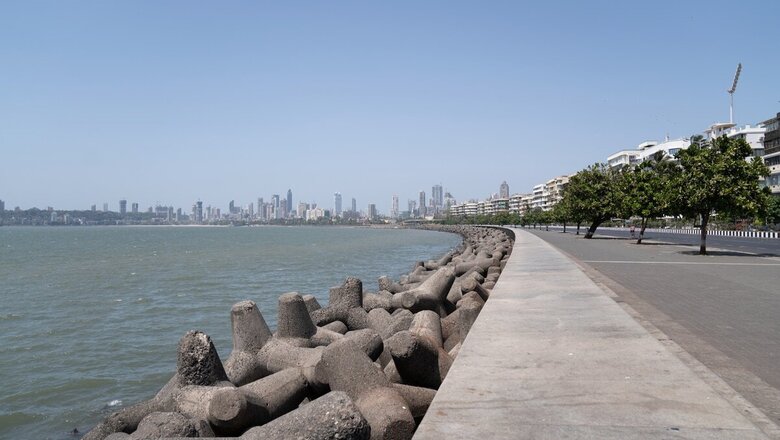
views
On 22 March, 2020, a 14-hour-long ‘janata curfew’ came into force after Prime Minister Narendra Modi urged people to stay indoors from 7 am to 9 pm to break the chain of spread of novel coronavirus. COVID-19 had already claimed four lives in the country and infected at least 169 others.
After a year has passed the world has still not returned to normalcy and several states are reporting a fresh wave of COVID-19 cases with speculations of another lockdown on its way. Several states have already announced a curb on Holi celebrations to tackle the ever increasing cases.
Here we take a look at what transpired since the first janata curfew:
March 24: 21-day lockdown imposed. Announcing the lockdown, Prime Minister Modi said it was not a curfew, but, given the seriousness of the matter, it should be treated as no less. In a tweet, he also assured that essential commodities will be available.
March 25: Migrants in large numbers head for their homes. By now, India has reported over 600 cases and has tested close to 20,000 individuals.
March 26: Finance Minister Nirmala Sitharaman announces a Rs 1.7 trillion economic stimulus plan that will be released through direct cash transfers and food security measures aimed at giving relief to millions of poor hit by the nationwide lockdown.
March 27: RBI announces that all banks, housing finance companies (HFCs) and NBFCs have been permitted to allow a moratorium of 3 months on repayment of term loans outstanding on March 1, 2020.
March 31: Delhi’s Nizamuddin area emerges as one of the Coronavirus ‘hotspots’ in India with a large number of attendees at a religious congregation being tested positive. India has now a total of 1,397 cases and has recorded 35 fatalities.
April 5: People respond to Prime Minister’s call to light up candles and diyas for nine minutes to dispel coronavirus darkness. The coronavirus cases jump to 3,577 and the death toll mounts to 83.
April 14: Centre extends lockdown till May 3. 10,000 confirmed cases were recorded till now. All states and UTs of India (except Dadar Nagar Haveli and Sikkim) report at least one case of Covid-19. India tested a total of 2,30,000 individuals.
April 16: Govt allows e-commerce, agri industry to resume from April 20. The government also allows farm activities, construction of roads and buildings in the hinterland which has so far been less affected by the coronavirus.
April 25: The government allows shops, including those located in residential complexes within municipal areas, to remain open at a 50 per cent strength.
April 30: Centre allows the movement of migrant labourers, students, pilgrims and tourists who do not have symptoms of coronavirus back to their home states.
May 1: Lockdown extended till May 17 with considerable relaxation in the districts falling in the Green and Orange Zones. All Red zone districts continue to stay under strict lockdown. The total number of corona cases in India rise to 42,505, with 1,391 people dead.
May 4: India enters Lockdown 3.0. The total number of coronavirus cases in the country reach 42,533 with 1,391 fatalities.
May 16: India with 85,940 cases overtakes China in terms of the total number of cases reported.
May 17: Lockdown extended till May 31.
May 31: India records 5,000 deaths.
June 8: Unlock 1.0- Phased reopening begins after 75 days of lockdown. India registers over 9,983 new coronavirus cases in a single day. The total coronavirus cases in India now stand at 260,093, and as many as 7,263 have died from the disease so far.
June 17: India registers the highest-ever spike of 2,003 Covid-19 deaths.
July 1: Country enters Unlock 2.0. Total number of coronavirus cases has exceeded the 600,000-mark. Around 17,495 fatalities from the disease.
July 15: Phase-1 clinical trials of India’s first indigenous Covid-19 vaccine, Covaxin, starts across the country. Zydus Cadila also starts human trials of its ZyCov-D vaccine.
July 17: International commercial flights resume as India establishes individual bilateral bubbles with France and the US. India’s total Covid-19 cases cross 10 lakh. Death toll stands at 25,600.
August 1: Phase 3.0 of Unlock comes into force, with govt allowing gymnasiums and yoga centres to function, and revoking the night curfew order.
August 29: Centre issues Unlock 4.0 guidelines, allows metro services to start from September 7, larger gatherings with 100 people allowed from September 21.
September 12: India breaks its own record in fresh Covid-19 cases, records another highest single-day spike in infections, with 97,570 people found coronavirus positive in 24 hours.
September 21: After remaining shut for the past six months, schools partially reopened in several states to enable students studying in Classes 9 to 12 to visit their institutions on a voluntary basis for taking guidance from their teachers.
Read all the Latest News, Breaking News and Coronavirus News here

















Comments
0 comment